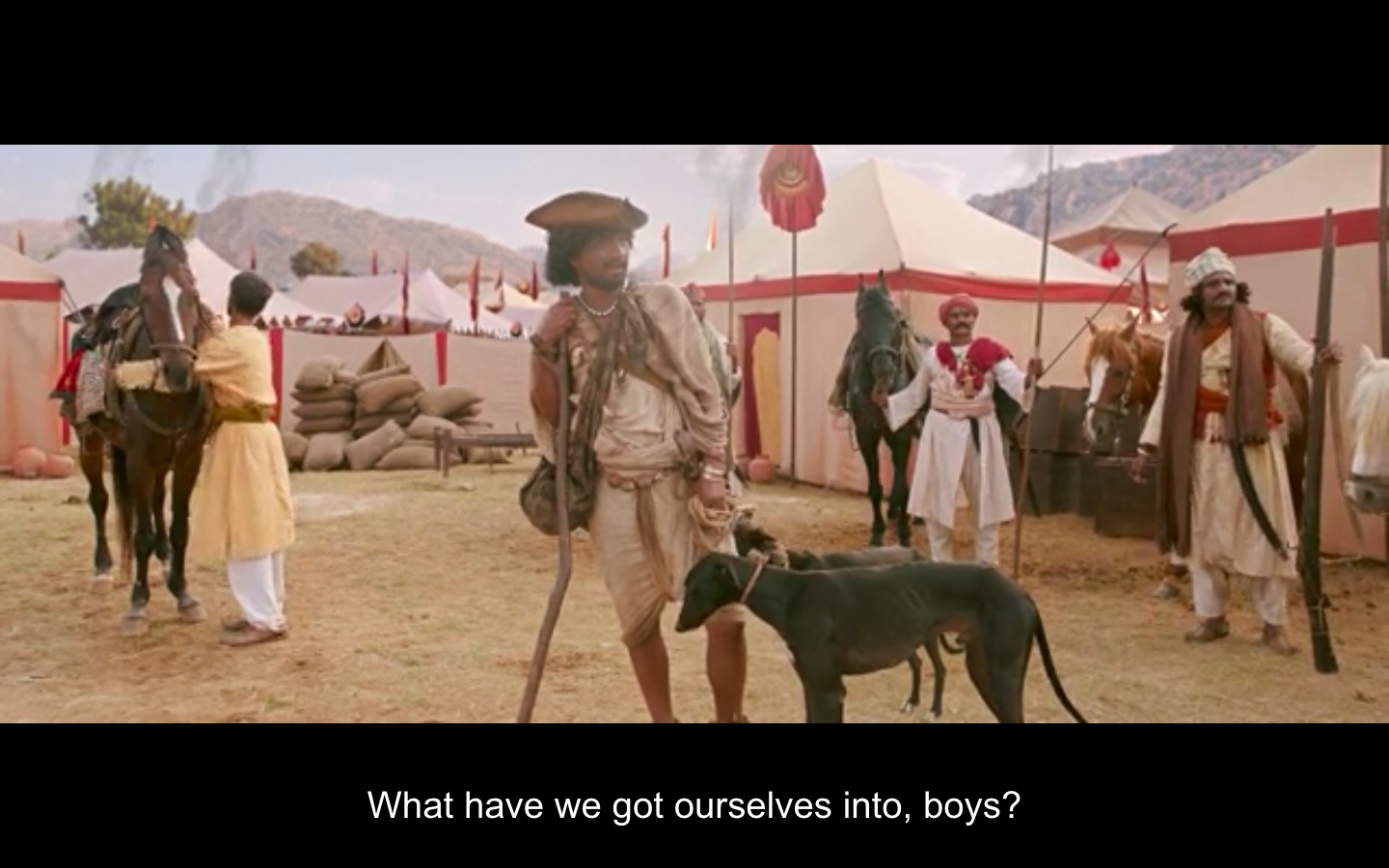… And then last year, when I saw the Pendulum, I understood everything.”
“Everything?”
“Almost everything. You see, Casaubon, even the Pendulum is a false prophet. You look at it, you think it’s the only fixed point in the cosmos, but if you detach it from the ceiling of the Conservatoire and hang it in a brothel, it works just the same. And there are other pendulums: there’s one in New York, in the UN building, there’s one in the science museum in San Francisco, and God knows how many others. Wherever you put it, Foucault’s Pendulum swings from a motionless point while the earth rotates beneath it. Every point of the universe is a fixed point: all you have to do is hang the Pendulum from it.”
– Umberto Eco, Foucault’s Pendulum
Review of Laal Kaptaan
Recently I saw the movie Laal Kaptaan (लाल कप्तान, literal translation Red Captain). Though I had seen the trailer when it was released sometime back this year, I did not see the movie. The visuals in the trailer were quite good, so I decided to finally watch it. And I was not disappointed. This is one of the few movies in recent times that I have managed to see in one shot. Or rather the movie managed to make me do it.
The major part of the movie is set in the region of Bundelkhand (literally the dominion of the Bundelas). This region which falls South-East of Agra and Delhi has historical places like Jhansi, Gwalior, Panna, Chhatarpur, Banda and Orchha within its folds has been historically important. The province of Awadh (Oudh) lies to the east of Bundelkhand and Ganges marks the boundary to the East, while the Rajputana lies to the West. The Yamuna divides the region into two, with the majority of the part lying to the West of Yamuna. The region between the two mighty rivers is known as a doab (marked yellow in the map below). Many of these were erstwhile princely states, which also existed until 1947, when they were merged with the Indian republic.

The era when the Mughal empire was disintegrating post the death of Aurangazeb in 1707, was especially tumultuous for this region. With the power vacuum created by the decaying Mughal empire being filled by the Marathas, by this time the Chatrapati was only a titular head and real power rested with the Peshwas and the various great houses of the Marathas (Shinde, Holkar, Bhosle, Gaikwad). The Marathas laid waste to large tracts and levied chauth ( collection of one-fourth of income ) on these regions mercilessly. But in general, they were hated in this region for their bullishness and general havoc they perpetrated on the public and places. For example, they looted the Red Fort in Delhi with impunity, scrapping off precious and semi-precious stones from the Diwan-e-Khaas to do a vasuli. (I might make a dedicated post for this later.)
If the Battle of Plassey (1757) was the founding stone of the British in India, then the battle of Buxar (1764) was the first real fortification of this foundation, and the British really established themselves in India as a potent force. Though the Marathas were the most powerful, the British did not engage with them directly until the end of the century. The third Battle of Panipat (1761), a few years before the battle of Buxar limited the Maratha presence in the North severely and was one of the major reasons that led to its full demise as a political and military power by the start of the next century. Though, this enabled the houses of Shinde, Holkar, Bhosle and Gaikwad to establish their own semi-independence over the Peshwas. Eventually, everyone became under the British. But the time in which the movie is set, the Marathas were still a force to reckon with and the EIC has just established itself as a millitary and political power in much of the region from Bengal to North India along the Gangetic plains.
The movie starts just after the Battle of Buxar (1764) when a large number of people are hanged outside the fortress of Shergarh (most probably a fictional place, as I could not find it anywhere in the sources). after the British win the battle. One of the persons who sides with the British named Rehmat Khan is especially despised upon, with him being called a gaddar (traitor) by the hanged. The accused are hanged on a huge banyan tree, with their bodies hanging like overgrown fruits along its branches. It is raining and in this scene, a young teenage boy promises Rehmat Khan that one day he will also hang on the same tree.
Fast forward 25 years (1789), we are taken to the den of a dacoit (डकैत /डाकू ) where the Bairagi called by another generic name Gossain (this term I had not heard before this film). He comes in and asks for fire for his chillam. Mayhem ensues and the hunter takes his prey. The entire scene starts with dark of the night and ends in the early morning.
The horde of warrior ascetics (of which were the Gossain/Naga) came to prominence in the resulting political instability and shifting sands post the fall of the Mughal empire.
…these orders became politically significant only after the collapse of the Mughal Empire, and more particularly after British activities created political and economic chaos in the second half of the eighteenth century.
Going forward, the hunter goes on to take his reward, where the local chieftain mocks him and doesn’t want to pay. He is made to pay by the Gossain. The film then follows the Gossain on his quest to locate and kill Rehmat Khan. Though there are hints that there is a link between the Gossain and the teenage boy who is hanged in the beginning, we are not sure how they are connected. I won’t go into the plot of the film, but will instead focus on some of the characters and background of the film.
Though some of the other reviews have portrayed the character of Rehmat Khan (played by Manav Vij) as just grunting. But I think he played the role very well, perhaps these reviewers are used to seeing villains as people who yell and show a lot of emosions on their faces. He subtly played the act of a cold-blooded, calculating and cruel character quite well and was never out of character. Rehmat Khan is a Rohilla. Now, the Rohillas were of an Afghan ethnicity, and they sided against the Marathas (led by Najib ad-Dawlah) with Ahemdshah Abdali during the third battle of Panipat. The Marathas were very enraged by this and Mahadji Shinde did collect his revenge on them a few years in 1772 after Panipat by destroying Rohilkhand and scattering bones of Najib ad-Dawlah. After this defeat, the First Rohilla war happened in which the British siding with the Nawab of Oudh defeated the Rohillas and the state of Rampur of established. The second Rohilla war, in 1794, between British and the Rohillas ended their supremacy in the region. Now, the time between the two wars, there was lot of guerilla activity carried out by the Rohillas, which led them to be set as Nawabs of Rampur. Given all this chaos and uncertainty, there were no permanent alliances or allegiances. The main part of Laal Kaptaan (c. 1789) is set in this era for the Rohillas. So, Rehmat Khan, a prominent Rohilla, defecting over to British was noteworthy, but not out of the line.
Pindaris
Pindaris were not a tribe, but a military system of bandits of all races and religions. They fluctuated in numbers, being augumented from time to timeby military adventurer from every State, and frequently amounted to as many as 30,000 men.
Pindaris present an episode in history of India, which is quite extraordinary, though skimmed upon in the history texts. Here we are witnessing a rise of a band of people whose existence was based on terrorising and looting people in distant provinces. The Pindaris were roughly active in the last three decades of eighteenth century to the first two decades of nineteenth. Earlier they were under tutelage of Maratha cheiftains who used them as militias to wreck havoc on supply lines of the enemies and disrupt civilian peace. So them accompanying the Maratha camp is completely normal. The depiction of the Pindari lust for the loot (tum log lo khazana, mai chala lene zanana) is well done in the film. In fact, the comedy of errors that the bunch sent to hunt down Rehmat Khan is something to relish. The frustration of the little Maratha knight in being unable to control them is well worth seeing.
But as the Maratha power came to a decline, the Pindaris in the nineteenth century became a force of their own, without masters. They would raid far, and were viscious and cruel in their tactics to make people pay. There are reports that people even committed suicides when they came to know that a Pindari raid was imminent.
Another thing worth mentioning in the film is the settings in which the film is shot. The cinematography is par excellence, set amongst fantastic fort ruins. I cannot identify the actual locations used in the film, so any information on that would be welcome.
The other character in the film worth mentioning is the Dog Walker played by Deepak Dobriyal. He has a pair of very fine Mudhol hounds (also known as Caravan hounds) named Sukhiram and Dukhiram.
 The character has no name in the film, but he finds people who are wanted for a price. That is how he makes his living. He refuses a horse mount saying it interferes with His character has many layers and he shares a special relationship with the Gossain, they respect each other. It was a treat to watch Dobriyal play this character with English hat and his greeting of:
The character has no name in the film, but he finds people who are wanted for a price. That is how he makes his living. He refuses a horse mount saying it interferes with His character has many layers and he shares a special relationship with the Gossain, they respect each other. It was a treat to watch Dobriyal play this character with English hat and his greeting of:
Howde do…

The two female characters in the film, one played by Zoya and other by Heena are in their niche. Zoya as a courtesan who is neglected, while Heena playing the wife of a chieftain carries herself well. Their characters are in emotional turmoil with maternal love and the surrounding situation.


The clothing, the artefacts are all era-appropriate and so are the languages used. A lot of work must have gone in background research and it shows in the quality of the film. Kudos to the production team for that. Just that the look of Saif has a semblance to Depp’s Jack Sparrow, that could have been avoided.
Overall a very watchable film, if you have not, do watch it.

PS: A special ode to Saif Ali Khan.
In my personal opinion, Saif Ali Khan has really matured as an actor over the years and has earned my respect for it. You can’t really compare his role in Yeh Dillagi and lets say his depiction of Langda Tyagi in Omkara. It is as if you are watching two completely different actors. The variety of roles he has done in recent times, and with grace is just amazing. He has done roles which many of the mainstream actors would shy away from. Hope that we see his good form in the future also.

References
Ersatz Coffee
Recently, I was traveling by train after a long time. The train, unfortunately, got delayed and I had to have breakfast in the train. So along with the breakfast, the server asked me if I want tea of coffee. Disclaimer: Nothing like Tea, Coffee or Me .
Now, tea or coffee in a train is a tricky affair. In trains that don’t have pantries, you usually get premade tea at stations, when the vendors start selling tea yelling “Chaiiiinnn, Chaiinn, Bolo Chaiiii”, read it like in a rhyme, with almost musical notes in the background. The tea is usually overboiled, with a high dose of sugar. Very rarely you would get black tea, with whitener and sugar in sachets. People who usually like tea, milk and sugar boiled together, don’t like the dip tea and vice versa. There is an interesting episode in the history of science that involves drinking tea. The idea for analysing randomised experiments was derived from whether one lady could tell whether the tea or the milk was added first to a cup.
The lady in question (Muriel Bristol) claimed to be able to tell whether the tea or the milk was added first to a cup. Fisher proposed to give her eight cups, four of each variety, in random order. One could then ask what the probability was for her getting the specific number of cups she identified correct, but just by chance.
This tea time question was developed as an analytical tool by R. Fisher and now has become a standard in design and analysis of experiments.
Every culture and sub-culture has its own way of making tea. In Bengal, I am told, people drink black tea. This perhaps is inspired by the British who introduced tea. George Orwell has an essay on how to make a nice cup of tea. Calcutta also had a substantial Chinese population perhaps this also contributed to the tea culture there. When tea was introduced to the general population in India, about a century back, it was a marketing stratagem. This is what my grandfather had told me, he was born in 1910s. Perhaps someone can actually look at the historical records to substantiate this. They would create tea in huge cauldrons in busy market places with lots of milk and sugar. They would advertise and give “free” samples to everyone. This is how they got an entire nation addicted to tea. Also a note about why the general teacup has loads of sugar and milk, whereas the typical English way of drinking tea does not involve loads of milk and sugar, and definitely does not involve boiling milk with tea. What you usually get is the dust tea, which does not taste well without loads of milk and sugar, like your Green or Earl Grey. To make it palatable it is loaded with milk and sugar. Try to drink your favourite dust tea like an Earl Grey.
Though there are people who will drink any kind of tea, their requirement is that of tea, not it’s quality or taste. Coffee is usually worse. When it is premade in trains, it has very little coffee and too much sugar. When they give you only hot milk it is pre-boiled with sugar, and thinned to its limits. Usually, the sachet of instant coffee contains too little in terms of coffee, at least for my taste. I usually avoid coffee when it is instant or premade, ever since I started to drink coffee from ground beans. I prefer tea in such cases, as
Bad coffee is worse than no coffee.
Anyways, so here I was sitting in the train, musing about the existential question of whether I should have tea or coffee or nothing at all, I decided to go with coffee. The smart, well-dressed server from IRCTC, handed over me a paper cup and a sachet with “काफी सामग्री” written over. Eff you if you can’t read the Devanagari script. I opened the sachet which had a sugar sachet, a coffee sachet and a milk powder sachet with a wooden spoon for mixing. Then he handed over a kettle containing hot water. I overcame a major, mental block while opening the sachets and pouring the coffee into the paper cup. Then I added a little water to maintain the colour to my liking. I was tempted to drink it black, but then why not go the entire routine. So I started to add the milk powder slowly as indicated on the sachet. The colour turned from darkest brown to slighter shade of brown. And it was ready. With a lot of anticipation of a caffeine kick, I sipped the liquid and…
“Ewwww!”
was my reaction. How can anyone call this coffee? It is not coffee! I even thought of starting a viral campaign with hashtag #NOTMYCOFFEE. Instead of delight it was despair. Thoughts of WHY? Why did I ever think this would be a good idea to drink this came to my mind? Somehow I managed to finish the cup in a couple of sips. I was left with a bad taste in my mouth, which I cannot describe, and the resulting reactions in my brain cells. It was a complete disaster. Never again! I would rather go without coffee than drinking this ersatz coffee. Once you know how actual coffee tastes like, you cannot go back to this. This is the same in the case of intellectuals too, once you know what an intellectual should be like, you can immediately sense the ersatz ones and you won’t like them just like the ersatz coffee.
Never again shall I drink this ersatz coffee.
I like my coffee as it is supposed to be. People become emosional on the account of coffee. For example, read this excellentest account of a French man from 1800s.
Edit 1: On the return journey, I actually tried something else. I had kept my South Indian style drip filter accessible with the coffee powder. Now, since the hot water is available in the form of flasks, I actually made hot decoction in the running train. But no hot milk was available, only milk powder, I had only the black coffee. It was definitely better than the ersatz coffee. Though the water I used for brewing could have been hotter.
On respect in the classroom
If you are a teacher (of any sort) and teach young people, don’t be disheartened if the students in your class don’t respect you or listen to you or maintain discipline. Even great philosophers like Socrates and Aristotle has a tough time dealing with their students
Socrates grumbled that he don’t get no respect: his pupils “fail to rise when their elders enter the room. They chatter before company, gobble up dainties at the table, and tyrannize over their teachers.” Aristotle was similarly pissed off by his students’ attitude: “They regard themselves as omniscient and are positive in their assertions; this is, in fact, the reason for their carrying everything too far.”Their jokes left the philosopher unamused: “They are fond of laughter and consequently facetious, facetiousness being disciplined insolence.”
– Judith Harris The Nurture Assumption
That being said, the students are also very perceptive about the knowledge of the teachers, and know who is trying to be a cosmetic intellectual.
Rotating Earth: the proofs or significance of Leon Foucault’s pendulum – Part 1

In an earlier post, we had discussed proofs of the round shape of the Earth. This included some ancient and some modern proofs. There was, in general, a consensus that the shape of the Earth was spherical and not flat and the proofs were given since the time of ancient Greeks. Only in the middle ages, there seems to have been some doubt regarding the shape of the Earth. But amongst the learned people, there was never a doubt about the shape of the Earth. Counter-intuitive it may seem when you look at the near horizon, it is not that counter-intuitive. We can find direct proofs about it by looking around and observing keenly.
But the rotation of Earth proved to be a more difficult beast to tame and is highly counter-intuitive. Your daily experience does not tell you the Earth is rotating, rather intuition tells you that it is fixed and stationary. Though the idea of a moving Earth is not new, the general acceptance of the idea took a very long time. And even almost 350 years after Copernicus’ heliocentric model was accepted, a direct proof of Earth’s rotation was lacking. And this absence of definitive proof was not due to a lack of trying. Some of the greatest minds in science, mathematics and astronomy worked on this problem since Copernicus but were unable to solve it. This included likes of Galileo, Newton, Descartes, and host of incredibly talented mathematicians since the scientific revolution. Until Leon Foucaultin the mid-1800s provided not one but two direct proofs of the rotation of the Earth. In this series of posts, we will see how this happened.
When we say the movement of the Earth, we also have to distinguish between two motions that it has: first its motion about its orbit around the Sun, and second its rotational motion about its own axis. So what possible observational proofs or direct evidence will allow us to detect the two motions? In this post, we will explore how our ideas regarding these two motions of the Earth evolved over time and what type of proofs were given for and against it.
Even more, there was a simple geometrical fact directly opposed to the Earth’s annual motion around the Sun and there was nothing that could directly prove its diurnal rotation. (Mikhailov, 1975)
Let us consider the two components of Earth’s motion. The first is the movement around the Sun along the orbit. The simplest proof for this component of Earth’s motion is from the parallax that we can observe for distant stars. Parallax is the relative change in position of objects when they are viewed from different locations. The simplest example of this can be seen with our own eyes.
Straighten your hand, and hold your thumb out. Observe the thumb with both the eyes open. You will see your thumb at a specific location with respect to the background objects. Now close your left eye, and look at how the position of the thumb has changed with respect to the background objects. Now open the right eye, and close the left one. What we will see is a shift in the background of the thumb. This shift is related by simple geometry to the distance between our eyes, called the baseline in astronomical parlance. Thus even a distance of the order of a few centimetres causes parallax, then if it is assumed that Earth is moving around the Sun, it should definitely cause an observable parallax in the fixed stars. And this was precisely one of the major roadblock
Earth moving around an orbit raised mechanical objections that seemed even more serious in later ages; and it raised a great astronomical difficulty immediately. If the Earth moves in a vast orbit, the pattern of fixed stars should show parallax changes during the year. (Rogers, 1960)
The history of cosmic theories … may without exaggeration be called a history of collective obsessions and controlled schizophrenias.
– Arthur Koestler, The Sleepwalkers
Though it is widely believed that Copernicus was the first to suggest a moving Earth, it is not the case. One of the earliest proponents of the rotating Earth was a Greek philosopher named Aristarchus. One of the books by Heath on Aristarchus is indeed titled Copernicus of Antiquity (Aristarchus of Samos). A longer version of the book is Aristarchus of Samos: The Ancient Copernicus. In his model of the cosmos, Aristarchus imagined the Sun at the centre and the Earth and other planets revolving around it. At the time it was proposed, it was not received well. There were philosophical and scientific reasons for rejecting the model.

First, let us look at the philosophical reasons. In ancient Greek cosmology, there was a clear and insurmountable distinction between the celestial and the terrestrial. The celestial order and bodies were believed to be perfect, as opposed to the imperfect terrestrial. After watching and recording the uninterrupted waltz of the sky over many millennia, it was believed that the heavens were unchangeable and perfect. The observations revealed that there are two types of “stars”. First the so-called “fixed stars” do not change their positions relative to each other. That is to say, their angular separation remains the same. They move together as a group across the sky. Imagination coupled with a group of stars led to the conceiving of constellations. Different civilizations imagined different heroes, animals, objects in the sky. They formed stories about the constellations. These became entwined with cultures and their myths.

The second type of stars did change their positions with respect to other “fixed stars”. That is to say, they changed their angular distances with “fixed stars”. These stars, the planets, came to be called as “wandering stars” as opposed to the “fixed stars”.
Ancient Greeks called these lights πλάνητες ἀστέρες (planētes asteres, “wandering stars”) or simply πλανῆται (planētai, “wanderers”),from which today’s word “planet” was derived.
Planet
So how does one make sense of these observations? For the fixed stars, the solution is simple and elegant. One observes the set of stars rising from the east and setting to the west. And this set of stars changes across the year (which can be evidenced by changing seasons around us). And this change was found to be cyclical. Year after year, with observations spanning centuries, we found that the stars seem to be embedded on inside of a sphere, and this sphere rotates at a constant speed. This “model” explains the observed phenomena of fixed stars very well.
The unchanging nature of this cyclical process observed, as opposed to the chaotic nature on Earth, perhaps led to the idea that celestial phenomena are perfect. Also, the religious notion of associating the heavens with gods, perhaps added to them being perfect. So, in the case of perfect unchanging heavens, the speeds of celestial bodies, as evidenced by observing the celestial sphere consisting of “fixed stars” was also to be constant. And since celestial objects were considered as perfect, the two geometrical objects that were regarded as perfect the sphere and the circle were included in the scheme of heavens. To explain the observation of motion of stars through the sky, their rising from the east and setting to the west, it was hypothesized that the stars are embedded on the inside of a sphere, and this sphere rotates at a constant speed. We being fixed on the Earth, observe this rotating sphere as the rising and setting of stars. This model of the world works perfectly and formed the template for explaining the “wandering stars” also.
These two ideas, namely celestial objects placed on a circle/sphere rotating with constant speed, formed the philosophical basis of Greek cosmology which would dominate the Western world for nearly two thousand years. And why would one consider the Earth to be stationary? This is perhaps because the idea is highly counter-intuitive. All our experience tells us that the Earth is stationary. The metaphors that we use like rock-solid refer to an idea of immovable and rigid Earth. Even speculating about movement of Earth, there is no need for something that is so obviously not there. But as the history of science shows us, most of the scientific ideas, with a few exceptions, are highly counter-intuitive. And that the Earth seems to move and rotate is one of the most counter-intuitive thing that we experience in nature.
The celestial observations were correlated with happenings on the Earth. One could, for example, predict seasons as per the rising of certain stars, as was done by ancient Egyptians. Tables containing continuous observations of stars and planets covering several centuries were created and maintained by the Babylonian astronomers. It was this wealth of astronomical data, continuously covering several centuries, that became available to the ancient Greek astronomers as a result of Alexander’s conquest of Persia. Having such a wealth of data led to the formation of better theories, but with the two constraints of circles/spheres and constant speeds mentioned above.
With this background, next, we will consider the progress in these ideas.
A stabilised image of the Milky Way as seen from a moving Earth.
Another Life – a review
I recently saw (or tried to) a sci-fi series titled Another Life on Netflix. The basic premise is in the first contact schema, wherein an alien spacecraft lands on Earth in the near future. The alien spacecraft looked cool, a rotating infinity sign. The promo and visuals looked nice hence I decided to watch.

The alien spacecraft lands and builds a crystal tower.
 It is not communicating and experts are trying to communicate with it via infrasound. The lead scientist here is the husband of the main protagonist Niki (who is captaining the spaceship Slavere being sent to investigate). So both are involved one in space and one on Earth in the matter. Now, no one is aware of whether the aliens are benevolent or malicious. They finally get to communicate with it by playing Western classical music, while the Salvere is en-route to its destination Pi Canis Majoris. So far so good.
It is not communicating and experts are trying to communicate with it via infrasound. The lead scientist here is the husband of the main protagonist Niki (who is captaining the spaceship Slavere being sent to investigate). So both are involved one in space and one on Earth in the matter. Now, no one is aware of whether the aliens are benevolent or malicious. They finally get to communicate with it by playing Western classical music, while the Salvere is en-route to its destination Pi Canis Majoris. So far so good.

Yet, I couldn’t get to like the series. I expected the show will gather plot and pace, once I get past the first few episodes. This happened to me in the case of The Expanse, it turned out to be really good after the first few episodes). The series sort of grows on you, but not this one, at least not for me.
The first offputting thing was the design of the space-ship Salvere. It is supposed to be the most advanced and well-equipped ship yet design-wise the ship is absolute crap. In the control room of the ship, all the crew is standing. Yes, standing! And when the ship does some somersaults, people and things get thrown off-board. I mean a simple design sense would dictate that there must be seats, especially in an artificial gravity ship which undergoes tremendous acceleration, but no, it instead goes

Space saftey 101: no seatbelts
Incidentally, the only person who is standing in the picture above is the holographic projection of the anthropomorphic computer named William onboard the ship. Hence, no inertia (well, technically speaking we are not in the GR domain) and hence sudden accelerations don’t affect him. I thought this would have been a one-off incidence, but things kept getting worse. After a mutiny, Niko kills her second in command over a decision which she takes a call which is not supposed to be tough enough. Was no psychological evaluation done? The highly trained team (including the computer) looks like it is a bunch of teenagers high on hormonal imbalance. They loose a lot of resources while trying to get a slingshot from Sirius. The scene of Niko looking at Sirius through an observation deck is strange. Sirius in all its blue glory (temperature equivalent of 9500 K) is seen overshadowing the observation port, yet the light on her face is equivalent to 5500 K, the colour of golden hour.


Blue light but yellow effect!
The pic in the middle is how the face is lit in the blue light of Sirius is shown in the series, right at least how it should be like. Perhaps the director is too heliocentric.
Now they are off to a planetoid they discover randomly moving across space to mine for crystals which contain a lot of water. I mean how much two people in spacesuits can mine by hand? Surely not enough to fulfill the requirements of a spaceship.

This big suitcase will carry all our requirement of oxygen and hydrogen.
Anyways they come back in a hurry because of a life-threatening “earthquake” on another planet. One of the members of the crew is infected with a boron-based virus that kills one of the staff and infects all of them. The nervous system coming out of the host is one gruesome scene, though reminiscent of H. R. Giger‘s creature emerging from the host in Aliens. The crew discovers that it is airborne and the entire ship is infected with it. Then they find a cure that irradiating by gamma rays will kill the virus. Ergo the electromagnetic shields are brought down so that gamma rays from Sirius can enter the ship and disinfect it. If anything, gamma rays are not affected by electromagnetic fields at moderate levels, though they are electromagnetic in nature. They are not visible to us, neither we can feel them immediately.

Achtung: Gamma ray march begins!

Constipating out boron-based virus with gamma radiation
Yet the crew is bathed in a white light of gamma rays, and after contortions of their faces as if constipating they are cured. Magically no radiation sickness happens. How their own DNA and on-board electronics are not fried is a question worth pondering.
Moving forward, they discover a similar signal to the one earth coming from one of the moons. They find extraterrestrial life there. Which surprisingly is very much like the earth, including its atmosphere and also has liquid water. Now thankfully, at least they are not drawing water by bucket, but by a spaceship.

A nice-cozy stroll on an unknown alien planet teeming with alien life
They find a planet full of alien life, and yet their reaction is so underwhelming. Read this statement in an as dead and as serious and slow voice you can
The excitement is killing me.
They rely completely on the computer to run the scans for any bio-hazard and find no problems at all. This is rather strange, I mean you are effing landing on an alien planet full of alien life and yet you don’t even put a spacesuit? Elementary error. They are not even bothered by the eerie similarity of the planet with earth, neither want to investigate the biochemistry. A rather strange (and dull) space crew who is not thrilled by the discovery of ET life. Through the day, they see only plant life. Even taste fruits by rubbing them on the skin and the licking a bit before eating! C’mon.
At the day end, they are attacked by alien animals (hexpods). They somehow get back to the spaceship without being eaten. And they are scanned and decontaminated, and yet an alien offspring manages to get onboard. So much for the decontamination and the automatic facility.

 Then who am I?
Then who am I?
A few moments later, the friendly onboard computer loses its circuits. And gravity goes off in the section where Niko is working. And she floats upwards… No magnetic boots on board a spaceship in zero gravity!? I mean this is not even wrong.

Look no hands and I am floating.
Now, the artificial gravity on board Salvere is induced by rotation of the ship. In order to remove it, you will have to stop the rotation and it will affect the entire ship. But here it is hown to affect only one room, while in the next room it is normal. Gravity cannot be turned on or off at will. It stays.
About the warp speeds and lights years, they show the ship can travel. We are told it is 3 months onward and 3 months return journey (a total of six months). Considering that Sirius is at about 8 light-years, it has to be a warp drive. As even going at very high speeds will take certainly more than 8 years, one way. But then if it is indeed a warp drive, why do we need that much time? Also, the ship has a sleeping/hibernating soma technology about which also I can rant, but won’t. There is another parallel plot developing on Earth with the crystal tower and trying to communicate with it, which I found even more boring.
I gave the serial a try for 5 full episodes but cannot do this further. If it cannot get its act together by this time, I guess it won’t in the future. It is a torture to watch so many commonsensical and scientific principles getting butchered. When there are so many amazing sci-fi stories that can be serialised, why these without any depth or even elementary sense are being made?
If I had to write, at least I would not make such elementary scientific blunders or plot with so many holes. Maybe I should write one, perhaps I have enough negative expertise on this topic now so that it won’t be as bad as some of them. Phew! I just stop it here as one of the bad-mouthing characters in the series sums it up for me

The infinity sign shaped spaceship seduced me to watch this, you have been warned, watch it at your own risk
On wearing branded stuff
I always felt uncomfortable when clothing or wearable accessories have an incredibly large amount of space for their own branding. I usually avoid such stuff when the brand name takes over the product. There are certain brands that do that, every item they produce will have an unreasonably large amount of real estate in the product to their own logo. I thought this was crappy/bad design. But it actually works, as people actually buy the product because it has that ultra visible branding. And people like to show other people that they are wearing something branded. As long as it is subtle and occupies the minimum space it requires, I am okay with it, but anything larger is a complete putoff. At more times than I can remember I have not bought clothes that have too much branding even if I like other attributes (color/texture/cut). I always felt it as odd to have too much branding on myself and somehow I could not explain this feeling of uneasiness, as I could not exactly pinpoint the cause of this discomfort, or put it in words (or both). Recently I read something which resonated perfectly with my own thought process (is there a word for what I have just described: a single word describing the feeling). Anyways here is an entry from a great blog which describes that feeling:
When you see someone sporting a shirt with the manufacturer’s name inscribed in bold letters across the chest, it’s hard to ignore the irony. The wearer is paying the company to promote its name, rather than vice versa. For the privilege of being a walking billboard, the purchaser may have paid many times the normal price of that product.
So next time you wear a pair of shoes with that logo, or a pair of pants with some large initials stitched on them, or a shirt with a brightly painted name, remember, you’re inadvertently advertising the company. The word “advertise” comes to us from Latin advertere meaning “to turn toward” or “to pay attention”. The word “inadvertently” derives from the same source. In other words, by not paying attention, we ARE paying attention.
Now, the aesthetics of branding is something that can have personal preferences. I like mine subtle not garish, better still if it is not at all visible to others. It is like the aesthetical difference between pornography and artistic nude. You know it when you see it.
Cosmetic Intellectuals (+ IYI)
In the last few years, the very connotation of the term intellectual has seen a downward slope. Such are the times that we are living in that calling someone an “intellectual” has become more like an insult rather than a compliment: it means an idiot who doesn’t understand or see things clearly. Now as the title of the post suggests it is this meaning, not the other meaning intellectuals who know about cosmetics. Almost two decades back Alan Sokal wrote a book titled Intellectual Impostures, which described quite a few of them. In this book, Sokal exposed the posturing done by people of certain academic disciplines who were attacking science from a radical postmodernist perspective. What Sokal showed convincingly through his famous hoax, is that many of these disciplines are peddling out bullshit with no control over the meaning contained. Only the form was important not the meaning. And in the book, he takes it a step forward, showing that this was not an isolated case. He exposes the misuse of the technical terms (which often have precise and operational meanings) as loose metaphors or even worse completely neglecting the accepted meaning of those terms. The examples given are typical, and you cannot make sense of what is being written. You can read, but cannot understand. It makes no sensible meaning. At this point, you start to doubt your own intelligence and intellectual competence, perhaps you have not read enough to understand this complex piece of knowledge. It was after all written by an intellectual. Perhaps you are not aware of the meaning of the jargon or their context, hence you are not able to understand it. After all there are university departments and journals dedicated to such topics. Does it not legitimise such disciplines as academic and its proponents/followers as intellectuals? Sokal answered it empirically by testing if presented with nonsense whether it makes any difference to the discipline. You are not able to make sense of these texts because they are indeed nonsensical. To expect any semblance of logic and rationality in them is to expect too much.
Nassim Taleb has devised the term Intellectual Yet Idiots (the IYI in the title) in his Incerto series. He minces no words and takes no bullshit. Sokal appears very charitable in comparison. Taleb sets the bar even higher. Sokal made a point to attack mostly the postmodernists, but Taleb bells the cats who by some are even considered proper academics, for example, Richard Dawkins and Steven Pinker. He considers entire disciplines as shams, which are otherwise considered academic, like economics, but has equal if not more disdain to several others also, for example, psychology and gender studies. Taleb has at times extreme views on several issues and he is not afraid to speak of his mind on matters that matter to him. His writings are arrogant, but his content is rigorous and mathematically sound.
they aren’t intelligent enough to define intelligence, hence fall into circularities—their main skill is a capacity to pass exams written by people like them, or to write papers read by people like them.
cosmetic
- relating to treatment intended to restore or improve a person’s appearance
- affecting only the appearance of something rather than its substance
It is the second sense that I mean in this post. It is rather the substance of these individuals that is only present in the appearance. And as we know appearance can be deceiving. Cosints appear intellectuals, but only in appearance, hence the term cosmetic. So how does one become a Cosint? Here is a non-exhaustive list that can be an indicator (learn here is not used in the deeper sense of the word, but more like as in rote-learn):
- Learn the buzzwords: Basically they rote learn the buzzwords or the jargon of the field that they are in. One doesn’t need to understand the deeper significance or meaning of such words, in many cases just knowing the words works. In the case of education, some of these are (non-comprehensive): constructivism, teaching-learning process, milieu, constructivist approaches, behaviorism, classroom setting, 21st-century skills, discovery method, inquiry method, student-centered, blended learning, assessments, holistic, organic, ethnography, pedagogy, curriculum, TLMs. ZPD, TPD, NCF, RTE, (the more complicated the acronyms, the better). More complicated it sounds the better. They learn by association that certain buzzwords have a positive value (for example, constructivism) and other a negative one (for example, behaviorism) in the social spaces where they usually operate in, for example, in education departments of universities and colleges. Not that the Cosints are aware of the deeper meaning of there concepts, still they make a point of using them whenever possible. They make a buzz using the buzzwords. If you ask them about Piaget, they know the very rudimentary stuff, anything deeper and they are like rabbits in front of flashlight. They may talk about p-values, 𝛘2 tests, 98.5 % statistical significances, but when asked will not be able to distinguish between dependent and independent variables.
- Learn the people: The CosInts are also aware of the names of the people in their trade. And they associate the name to a concept or of a classic work. They are good associating. For example, (bad) behaviorism with Burrhus F. Skinner or Watson, hence Skinner bad. Or Jean Piaget with constructivism and stages (good). Vygotsky: social constructivism, ZPD. Or John Dewey and his work. So they have a list of people and concepts. Gandhi: Nayi Taleem. Macauley: brought the English academic slavery on India (bad).
- Learn the classics: They will know by heart all the titles of the relevant classics and some modern ones (you have to appear well-read after all). Here just remembering the names is enough. No one is going to ask you what was said in section 1.2 of Kothari Commission. Similarly, they will rote learn the names of all the books that you are supposed to have read, better still carry a copy of these books and show off in a class. Rote learn a few sentences, and spew it out like a magic trick in front of awestruck students. Items #1 through #3 don’t work very well when they have real intellectual in front of them. A person with a good understanding of basics will immediately discover the fishiness of the facade they put up. But that doesn’t matter most of the time, as we see in the next point.
- Know the (local) powerful and the famous: This is an absolute must to thrive with these limitations. Elaborated earlier.
- Learn the language aka Appear academic (literally not metaphorically): There is a stereotype of academic individuals. They will dress in a particular manner (FabIndia?, pyor cotton wonly, put a big Bindi, wear a Bongali kurta etc, carry ethnic items, conference bags (especially the international ones), even conference stationery), carry themselves in a particular manner, talk in a particular manner (academese). This is also true of wannabe CosInt who are still students, they learn to imitate as soon as they enter The Matrix. Somehow they will find ways of using names and concepts from #1 #2 #3 in their talk, even if they are not needed. Show off in front of the students, especially in front of the students. With little practice one can make an entire classroom full of students believe that you are indeed learned, very learned. Any untoward questions should be shooed off, or given so tangential an answer that students are more confused than they were earlier.
- Attend conferences, seminars and lectures: The primary purpose is network building and making sure that others register you as an academic. Also, make sure that you ask a question or better make a tangential comment after the seminar so that everyone notices you. Ask the question for the sake of asking the question (
evenespecially if you don’t have any real questions). Sometimes the questions devolve into verbal diarrhea and don’t remain questions and don’t also have any meaning that can be derived from them (I don’t have a proper word to describe this state of affairs, but it is like those things which you know when you see it). But you have to open your mouth at these events, especially when you have nothing substantial/meaningful to say. This is how you get recognition. Over a decade of attending various conferences on education in India, I have come to realise that it is akin to a cartel. You go to any conference, you will see a fixed set of people who are common to these conferences. Many of these participants are the cosints (both the established and the wannabes). After spending some time in the system they become organisers of such conferences, seminars and lectures definitely get other CosInts to these conferences. These are physical citation rings, I call you to my conference you call me to yours. Year after year, I see the same patterns, so much so I can predict, like while watching a badly written and cliche movie, what is going to happen when they are around. That person has to ask a question and must use a particular buzzword. (I myself don’t ask or comment, unless I think I have something substantial to add. Perhaps they think in same manner, just that their definition of substantial is different than mine.) Also, see #5, use the terms in #1, #2 and #3. Make sure to make a personal connection with all the powerful and famous you find there, also see #4. - Pedigree matters: Over the years, I have seen the same type of cosints coming from particular institutions. Just like you can predict certain traits of a dog when you know its breed, similarly one can predict certain traits of individuals coming from certain institutions. Almost without exception, one can do this, but certain institutions have a greater frequency of cosints. Perhaps because the teachers who are in those places are themselves IYI+cosints. Teaching strictly from a prescribed curriculum and rote-learning the jargon: most students just repeat what they see and the cycle continues. Sometimes I think these are the very institutions that are responsible for the sorry state of affairs in the country. They are filled to the brim with IYIs, who do not have any skin in the game and hence it doesn’t matter what they do. Also, being stamped as a product of certain institution gives you some credibility automatically, “She must be talking some sense, after all he is from DU/IIT/IIM/JNU/”
- Quantity not quality: Most of us are not going to create work which will be recognised the world over (Claude Shannon published very infrequently, but when he did it changed the world). Yet were are in publish or perish world. CosInts know this, so they publish a lot. It doesn’t matter what is the quality is (also #4 and #5 help a lot). They truly are environmentalists. They will recycle/reuse the same material with slight changes for different papers and conferences, and surprisingly they also get it there (also #4 and #5 help a lot). So, at times, you will find a publication list which even a toilet paper roll may not be able to contain. Pages after pages of publications! Taleb’s thoughts regarding this are somewhat reassuring, so is the Sokal’s hoax, that just when someone has publications (a lot of them) it is not automatic that they are meaningful.
- Empathisers and hypocrites: Cosints are excellent pseudo-emphatisers. They will find something to emphathise with. Maybe a class of people, a class of gender (dog only knows how many). Top of the list are marginalised,
poorlow socio-economic status, underprivileged, rural schools, government students, school teachers, etc. You get the picture. They will use the buzz words in the context of these entities they emphathise with. Perhaps, once in their lifetimes, they might have visited those whom they want to give their empathy, but otherwise, it is just an abstract entity/concept.(I somehow can’t shake image of Arshad Warsi in MunnaBhai MBBS “Poor hungry people” while writing about this.) It is easier to work with abstract entities than with real ones, you don’t have to get your hands (or other body parts) dirty. The abstract teacher will do this, will behave in this way: they will write a 2000 word assignment on a terse subject. This is all good when designing things because abstract concepts don’t react in unwanted ways. But when things don’t go as planned in real world, teachers don’t react at all! The blame is on everyone else except the cosints. Perhaps they are too dumb to understand that it is they are at fault. Also, since they don’t have skin in the game, they will tell and advise whatever they have heard or think to be good, when it is implemented on others. For example, if you talk to people especially from villages, they will want to learn English as it is seen as the language which will give them upward mobility. But cosints, typically in IYI style, some researchers found that it is indeed the mother tongue which is better for students to learn, it should be implemented everywhere. The desires and hopes of those who will be learning be damned, they are too “uneducated” to understand what they need. It is the tyranny of fake experts at work here.He thinks people should act according to their best interests and he knows their interests… When plebeians do something that makes sense to themselves, but not to him, the IYI uses the term “uneducated.” (SITG Taleb)
Now one would naturally want to know under what conditions that research was done? was there any ideological bias of the researchers? whether it is applicable in as diverse a country as India? What do we do of local “dialects”? But they don’t do any of this. Instead, they will attack anyone who raises these doubts, especially in #6. They want to work only with the government schools: poor kids, poor teachers no infrastructure. But ask them where their own children study: they do in private schools! But their medium must be their mother tongue right? No way, it is completely English medium, they even learn Hindi in English. But at least the state board? No CBSE, or still better ICSE. Thus we see the hypocrisy of the cosint, when they have the skin in the game. But do they see it themselves? Perhaps not, hence they don’t feel any conflict in what they do.
So we see that IYI /cosint are not what they seem or consider themselves. Over the last decade or so, with the rise of the right across the world is indicating to everyone that something is wrong when cosints tell us what to do. The tyranny of pseudo-experts has to go. But why it has come to that the “intellectuals” who are supposed to be the cream of the human civilisation, the thinkers, the ideators, so why the downfall? Let us first look at the meaning of the term, so as to be not wrong about that:
The intellectual person is one who applies critical thinking and reason in either a professional or a personal capacity, and so has authority in the public sphere of their society; the term intellectual identifies three types of person, one who:
- is erudite, and develops abstract ideas and theories;
- a professional who produces cultural capital, as in philosophy, literary criticism, sociology, law, medicine, science; and
- an artist who writes, composes, paints and so on.
Intellectual (emphasis mine)
Now, see in the light of the above definition, it indeed seems that it must be requiring someone to be intelligent and/or well-cultured individual. So why the change in the tones now? The reasons are that the actual intellectual class has degraded and cosints have replaced them, also too much theory and no connect with the real world has made them live in a simulacrum which is inhabited and endorsed by other cosints. And as we have seen above it is a perpetuating cycle, running especially in the universities (remember Taleb’s qualification). They theorize and jargonise (remember the buzzwords) simple concepts so much that no one who has got that special glossary will understand it). And cosints think it is how things should be. They write papers in education, supposedly for the betterment of the classroom teaching by the teachers, in such a manner that if you give it to a teacher, they will not be able to make any sense of it, leave alone finding something useful. Why? Because other cosints/IYI demand it! If you don’t write a paper in a prescribed format it is rejected, if it doesnt have enough statistics it is rejected, if it doesn’t give enough jargon in the form of theoretical review, and back scratching in the form of citations it is rejected. So what good are such papers which don’t lead to practice? And why should the teachers listen to you if you don’t have anything meaningful to tell them or something they don’t know already?
The noun to describe them:
sciolist – (noun) – One who engages in pretentious display of superficial knowledge.
On Books and Bookcases
“But I am apt to use my books at any time,” I explain to the salesman. “I never can tell when it is coming on me. And when I want a book I want it quickly. I don’t want to have to send down to the office for the key, and I don’t want to have to manipulate any trick ball-bearings and open up a case as if I were getting cream-puffs out for a customer. I want a bookcase for books and not books for a bookcase.”
– Robert Benchley
Myriad Mystical Melancholic Marathon Mindless Meaningless Meetings
There are meetings and then there are more meetings. There are meetings after meetings and there are meetings before meetings. There are meetings in the office, and there are meetings in conference rooms, sometimes in the cafeteria. There are online meetings, there are face-to-face meetings. There are app-based meetings, there are audio meetings, there are video meetings. There is a plethora of meetings. Sometimes my entire working day was lost in shuffling my mind and shuttling my body between meetings. Many times I think just attending meetings is the work, perhaps the only work, that people do. Some people take meetings with almost religious fervour in both quantity and quality. For me, any meeting which lasts more than 15-20 minutes, unless meeting exceptional people or under exceptional circumstances, is just plain debauchery full of verbal diarrhea. Meetings should be precise and to the point, and should not devolve into a seemingly unending saga like a TV Soap opera.
But then, people don’t believe in short meetings. They want elaborate, longer meetings. Mind you I have nothing against longer formats, I would rather read a long-form essay than a character restricted tweet. But these meetings suck the very life out of you as they progress. I could never explain that feeling of uneasiness that crept over me whenever I have to attend the glorious meetings which go on for 2 hours and some more. Longer meetings are like their contents like a gas, nothing concrete.
meetings will expand to fill whatever time is given to them. – Prof. Hall
I would always see others attending the same meeting in the same room, for the same time but never seeing them bored even a zilch. If anything, their enthusiasm for the meeting (whatever the topic) seems to go on and on, as if they had a Duracell battery inside them, and me has just an ordinary battery which runs out of juice in between the race, with the finish line seemingly lying beyond the horizon.

Do these people drink Boost? Is that the secret of their energy? I have to know this…
But sometimes during these marathon meetings, I have managed to get some creative things done, insulating and isolating myself from the chaos and debris. The important word to note is “sometimes”. Most of the time I was bored to death, thinking about existential questions about life, the universe and everything. But instead of loaded questions like “”What is life about?”” I end up asking much mundane (and cheap) ones like “What is this meeting about?, instead of “What is my purpose in life?”, I ask “What is the update I have to give?” At times I had to give the same updates in three different meetings in a single week. And then people want to talk about optimisation and time-saving techniques and how we can become more efficient, of course in a meeting.
During such moments of philosophical delirium, I take solace in thinking about this quote from Alice in Wonderland:
“ In that direction,” the Cat said, waving its right paw round, “ lives a Hatter : and in that direction,” waving the other paw, “ lives a March Hare. Visit either you like: they’re both mad.”
“ But I don’t want to go among mad people,” Alice remarked.
“ Oh, you can’t help that,” said the Cat : “ we’re all mad here. I’m mad. You’re mad.”
“ How do you know I’m mad ? ” said Alice.
“ You must be,” said the Cat, “ or you wouldn’t have come here.”
Of course, why would I go to a boring meeting which gives me both suicidal and mass-murderous thoughts at the same time, unless I am mad? After every single of these myriad marathon meetings, I would comment to myself with deep melancholy “I am never going to get back these hours of my life I have spent/survived in here”.

Detail from Melencolia I by Albrecht Dürer
Not that I am the only one with these feelings, the shoulders are stooped, faces drained and brains faded for many fellow tortured souls. For all the knowledge of cognitive and educational psychology that many of my learned colleagues are making a living from, they just cannot ( or rather do not) want to see the problems with meetings which apparently stretch on and on. They think just sitting there will help in building the team and inspiring people and keep them updated. They are wrong. Meetings, especially the long ones, don’t help.
Motivation and concentration, cannot be kept on for long, especially in contexts in which you are passively listening to a subject of not your liking. And, as I have remarked in an earlier post, the passage of time can be very subjective. In the case of such meetings, it seems that we are moving very close to the speed to light, as time seems to mysteriously pass very very slowly. I have many times found myself saying, “It must be at least 15 minutes since they are blethering…” and to my surprise when I check the actual time it is not even 2-3 minutes.
Hai Ram! Anyay hi anyay…
हाय राम ! अन्याय ही अन्याय।।।
Another aspect of long meetings is that they are not only mentally, but also physically draining. Even if you are just sitting at one place during those two hours, somehow the entire body feels drained of its juice (remember the Duracell bunny). Physiologically perhaps this can be explained as the entire body system tuning itself to go to sleep as there isn’t much physical activity, added to lessened mental activity as well. Perhaps this is also the reason why people fall asleep during meetings.

But about the general idea of meetings that I have is neither subjective nor unpopular opinion. People have researched and have come to the same conclusions.
Yet as valuable and energizing as good meetings can be, too many meetings are seen as a waste of time — as a source of frustration rather than enlightenment. – Rogelberg, Scott and Kelly – The Science and Fiction of Meetings (2007)
Also, the misconception that some people had (and I guess they still do) is that meeting is a type of work. It seems to them that attending a meeting itself is equivalent to doing work. Maybe they are fans of Full Metal Alchemist and inspired by law of equivalent exchange they think meeting about some work is equivalent to actually doing the meetings. So how do we end up having so many meetings anyway?
People don’t do concrete things any more,” he says.
Instead he says there has been a rise of managerial roles, which are often not very well defined, and where “the hierarchy is not that clear”.
“Many managers don’t know what to do,” he says, and when they are “unsure of their role”, they respond by generating more meetings.
“People like to talk and it helps them find a role,” says the professor.
Many of these people can spend half of their working hours in meetings, he says.
– Pointless work meetings
What this implies is that instead of doing actual work, people want to just talk about it. Yet some people, mysteriously seem to enjoy these meetings, some even recording attendance and taking meticulous notes, as if to provide an alibi for a murder.

Rogelberg, Scott and Kelly – The Science and Fiction of Meetings (2007)
That being said, I always thought who likes such meetings and why do they like it? I had a folk-psychological theory that those who enjoy such meetings actually derive their energies from such meetings. But all these were just shower-thoughts, I mean during these mindless meetings you can think of having a hot shower, and also think about something else at the same time. Your brain saves you, it automatically tunes out of the ambient noise and enables you to do what you want to. But this too has its limits and it is not always possible to do it. This is done of course with a filter and a trigger word. The trigger word is when someone calls your name. At times the image of me as Heisenberg flashes in front of my mental eyes as if I have sadistically commanded them to

And tathastu suddenly you are centre of attention and you have to pretend that you are supremely interested in the topic of the meeting (however boring) and have to respond. I still get goosebumps thinking about this (think PTSD level), imagine the trauma I must have experienced over the years. But the people who like such meetings seem to be immune to such traumas. Rather they thrive in such troubled waters.
The other reason that I had speculated for this was that these meetings are a form of a power play. Not the cricket kind, but the human politics kind. These meetings allow people to show the pecking order, and also allow them to tell other people things which they would not want to hear otherwise. It is to give those whom you like the work that they want and rest to the work they won’t.
A colleague of mine, who has whitened (ok wait, not whitened but grayed 🙂 his hair dealing day in and day out people like these and had experienced such meetings much more than me, told me about the dichotomy of such work distribution. Work, according to him, is of two types: Monkey work and Donkey work. Now, as the name suggests, monkey work is like monkey work. Monkeys are jovial, they jump from tree top to tree top, eat fruits that they like, raid houses and steal from them, make noises and if you get too close to one they might attack you too. They are the Bandar Log of Kipling.

In Hindi, Bandar means “monkey” and log means “people” – but can also be used for plurality hence the term simply refers to “monkeys”. The term has also since come to refer to “any body of irresponsible chatterers.”
All said and done, monkeys enjoy life, and people do remember them. They have their own charm and are the most visible and vocal people of the jungle (office?). Now I know, you must be making mental images of who are possible Bandar log in your office while reading this. But they don’t do any real work, they do pretend work. They want their names on events that are seen as glamorous and titles which pompous. But you assign them ass grinding work, they will throw a tantrum as if you have asked them their kidneys, for free. It is not that they don’t want to do quality work, in reality, they can’t get quality work done.
In most cases, the monkey working class is also of the mediocre people which I had written about in the past. It is beyond their ken and competence do get actual work done. Perhaps it is the infinite monkey theorem at work.
The infinite monkey theorem states that a monkey hitting keys at random on a typewriter keyboard for an infinite amount of time will almost surely type any given text, such as the complete works of William Shakespeare. In fact, the monkey would almost surely type every possible finite text an infinite number of times. However, the probability that monkeys filling the observable universe would type a complete work such as Shakespeare’s Hamlet is so tiny that the chance of it occurring during a period of time hundreds of thousands of orders of magnitude longer than the age of the universe is extremely low (but technically not zero).

Since we do not have infinite time or millions of Bandar log in our office, the chances of them producing any intelligible work is extremely low (but technically not zero). So now you know why work doesn’t get done.
If at all, such work befalls on them like on the protagonist of a Greek tragedy, they insist on having an ensemble of underlings to work with under them. They will assign all work to them and only pitch in when to take the credit. They usually undertake work which does not have concrete objectives, or immediate deliverables. They like work which is vague, sounds inscrutable and is heavily jargonised. And they look and dress much well. They look and talk sophisticated but on a closer/deeper scrutiny what remains is only sophistry. Such are the monkey-work people.
On the other hand, the Donkey work people suffer similar fate to the eponymous animal. They do drudgery and actual work which is not glamorous. They work tirelessly and without much hope for recognition. Most actual work in the office is done by them. And in these meetings, this distinction is made clear.
If you work more, more work will come to you. If you work less, less work will come to you.
The offices run on the basis of the work of the Donkey-work people. Boxer the cart horse from Animal Farm can be considered as a Donkey-work person, though all of us are not that naive or ignorant. 
Another aspect of such meetings is the apparent loss of time-sense some people experience when their turn to speak, Csikszentmihalyi will perhaps call it as flow state. It feels like those old people who usually don’t get to talk, and when they get someone they just keep on going. It is as if some people have to complete a quota of words in front of a captive audience in order to satiate themselves. Even if what they are saying is of no importance, or is not in the agenda of the meeting or is meaningless mindless mouthing. It is like a poison that they want to remove from their bodies and minds and in lieu inject it on the hapless captive attendees. There is no dialogue, only monologue. In doing so, they inadvertently, and purposefully they hijack the agenda of the meeting. They will go on and on about ephemeral experiences they have had, for example, elaborately explaining elegant endoscopy (or enema, choose what you will).
The cry baby gets more attention.
Initially, I used to think, it is harmless banter, excruciatingly boring at worst but then it turned out to be sinister scheming. This is true for humans as much as for animals. In birds, the more vocal and active chick gets all the food, while not so vocal ones are starved and at times kicked out of the nest by their siblings. In the case of humans, this is observed too. Babies who cry more, get more food and parents time. They know how to manipulate people around them even by faking crying.
The infants exhibited crying behavior that seemed to become more sophisticated with increasing age. This marked a proactive stance in communicating with the mother on the part of the infant. Interestingly, at 11–12 months, “fake crying” was observed during a naturalistic interaction with the mother. This implied that deceptive infant behavior could be seen at quite an early stage.
Now, I am not sure if this trait is carried to adulthood or it is learned during the intervening years, but they get the same modus operandi seems to work on adults also. In these meaningless meetings, the banter can be seen analogous to crying, and attention whoring. The hijacking of the agenda has another purpose, to eat up the time allotted to others, in case you want to say something of value, such delays will cut down your time. Such episodes remind me of an aunty who makes horrible food but insists that everyone must eat it to the full and also praise her culinary skills.
And if they can, people will put all the content of what they have to speak on slides. If you can’t read it yourself (even if you are seated in the front row), because they have put 10 bullet points at 10 point font on a single slide? Not a problem, they are just anyway going to read aloud the slides. Technology scaffolded GIGO. When I see such slides, the designer in me dies a thousand deaths. And people are This goes against good design principles of presentations. Powerless Pointless Talks (PPTs) can be indeed empowering for these people. I can go on ranting about this, but since this is not the central theme of this post, hence I will stop here.
Another category of monkey workers are sly. When they have to address such meetings or are tasked with providing some answers they work as follows. They will identify possible candidates who might have the knowledge that they require. lf Suppose fate has it, that it is you who they seek. Then they will clandestinely ask you something about some other topic and slowly, but surely drift to the subject they want. Then they will ask you detailed questions, and innocently you will answer. The episode ends there, or so you think. Next time in the meeting, you hear your own words coming out of their mouth. No, you are not controlling their minds! But this is a way of appropriating knowledge. They feel elated and intelligent by telling all others what you have told them and not at a single point giving you any credit or even hinting that they asked you anything. Such is the state of people and the purpose they use the meetings for,
Some of these were just some empirical, albeit biased speculations. Can there be a scientific explanation to this messy behavior in meetings? It turns out there is. Recently a group of psychologists from Sweden did actually study work meetings. And this study enables us to understand many things about meetings.
They say meetings provide an outlet both for people to show off their status or to express frustration. Mine is, of course, the latter case (at least I would want to identify myself as such, my residual self-image), while the monkey people show off their status. They say despite there being more meetings “few decisions are made” and people can have a low opinion of work meetings, yet their numbers keep increasing.
The Swedish study takes another take on the long meetings:
Meetings can “arouse feelings of meaninglessness”, he says. But he argues that is often missing their point.
Once in a meeting – particularly long ones – their function can become “almost therapeutic”.
Regardless of what they are meant to be discussing, they serve a purpose as an “opportunity to complain and be acknowledged by colleagues”.
But this certainly becomes a farce very quickly.
But people going to many meetings can lose patience – and can spend much of the time playing with their mobile phones, say the researchers.
A very common scene in meetings that I have had to endure, and surely you have too.
“Some people find this frustrating and question why they must endure them.”
Then he comes to the crucial insight of the study.:
But he argues that negativity towards meetings can be because their real purposes are misunderstood. (emphasis added)
But he says the real purpose of such meetings might be to assert the authority of an organisation, so that employees are reminded that they are part of it.
Such meetings are not really about making any decisions, he says. (emphasis added)


Levels of meeting and power play.
“When you have meetings with colleagues at the same level, as a professional, you get to discuss different issues that interest you,” he says.
When the meetings are dominated by different levels of status, they become a “power struggle” and leave participants feeling frustrated.
He also says that meetings can unfairly become the focus of other dissatisfactions.
“People often feel marginalised. They feel that they have no influence or position. In these cases, the perception is that meetings do not improve anything, but actually cause even more frustration.”
– Pointless work meetings
Anyways, now we know why the malaise of meetings is not going to go away, as it is
- considered as a legitimate form of work by people who do not produce any concrete work;
- a way to show off one’s status and power in the workplace among your peers;
- a way to dominate and frustrate hapless underlings;
- a way of attention (and implicitly resource) grabbing behavior.
So much for the seemingly myriad and mystical, yet melancholic and mindless meaningless marathon meetings, hope to see you in your next one (No, I really don’t).








